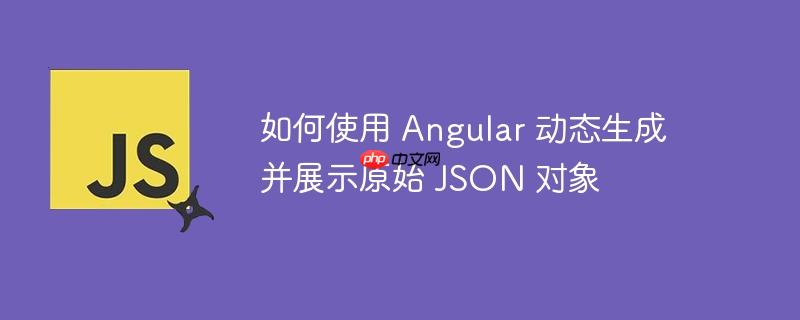
在现代前端应用开发中,有时我们需要让 Angular 应用在特定路由下“响应”一个动态生成的 JSON 对象,而不是传统的 HTML 界面。这在某些特定场景下尤为有用,例如:
虽然 Angular 本身不是一个后端服务器,不能直接提供纯粹的 HTTP JSON 响应头,但我们可以通过一个组件来渲染 JSON 字符串,从而达到类似的效果,特别是当目标消费方(如 <iframe>)能够解析组件渲染出的 HTML 内容时。
为了实现在 Angular 中动态生成并展示 JSON 对象,我们将主要依赖以下 Angular 核心模块和特性:
我们将创建一个名为 Echo 的 Angular 组件,它将根据 URL 中的查询参数来动态生成并显示 JSON 数据。
首先,在 Angular 项目的 src/assets/ 目录下创建一个静态 JSON 文件,例如 hello.json。这个文件将作为我们动态生成 JSON 的基础模板。
src/assets/hello.json:
{
"hello": ""
}接下来,创建一个 Echo 组件。这个组件将负责:
src/app/echo.component.ts:
import { Component, inject, OnDestroy, OnInit } from '@angular/core';
import { ActivatedRoute } from '@angular/router';
import { firstValueFrom, Subscription } from 'rxjs';
import { HttpClient } from '@angular/common/http';
@Component({
selector: 'echo',
template: `
<pre>{{ jsonData | json }}</pre>
`,
styles: [`
/* 可选:为 pre 标签添加一些样式,使其更像原始 JSON 输出 */
pre {
white-space: pre-wrap;
word-wrap: break-word;
background-color: #f5f5f5;
padding: 15px;
border-radius: 4px;
font-family: monospace;
color: #333;
}
`]
})
export class Echo implements OnInit, OnDestroy {
private http = inject(HttpClient);
private queryParamSubscription: Subscription | undefined;
private readonly activatedRoute = inject(ActivatedRoute);
jsonData: any;
async ngOnInit(): Promise<void> {
// 订阅 queryParamMap,以便在 URL 查询参数变化时更新 JSON 数据
this.queryParamSubscription =
this.activatedRoute.queryParamMap.subscribe(async (map): Promise<void> => {
// 从 URL 查询参数中获取 'input' 和 'jsonPath'
const input = map.get('input') as string;
const jsonPath = map.get('jsonPath') as string;
if (!jsonPath) {
// 如果没有提供 jsonPath,可以设置一个默认的错误或空 JSON
this.jsonData = { error: "jsonPath query parameter is required." };
return;
}
try {
// 调用辅助方法获取 JSON 模板数据
const jsonFileData = await this.getJsonData(jsonPath);
// 根据 'input' 参数动态修改 JSON 数据
// 这里的逻辑可以根据实际需求进行扩展
if (jsonFileData && typeof jsonFileData === 'object' && 'hello' in jsonFileData) {
jsonFileData.hello = input || "default_value"; // 如果 input 不存在,提供一个默认值
} else {
// 如果模板结构不符合预期,可以创建新的结构
this.jsonData = { input_received: input, original_template: jsonFileData };
return;
}
// 更新组件的 jsonData 属性,触发视图更新
this.jsonData = jsonFileData;
} catch (error) {
console.error('Error fetching or processing JSON data:', error);
this.jsonData = { error: "Failed to load or process JSON template.", details: (error as Error).message };
}
});
}
/**
* 从 assets 文件夹获取 JSON 数据。
* @param path JSON 文件的路径,例如 'hello.json'。
* @returns 包含 JSON 数据的 Promise。
*/
getJsonData(path: string): Promise<any> {
// 使用 HttpClient 获取 JSON 文件
// firstValueFrom 用于将 Observable 转换为 Promise
return firstValueFrom(this.http.get<any>(`assets/${path}`));
}
ngOnDestroy(): void {
// 在组件销毁时取消订阅,防止内存泄漏
if (this.queryParamSubscription) {
this.queryParamSubscription.unsubscribe();
}
}
}为了能够通过 URL 访问 Echo 组件,我们需要在 app-routing.module.ts 中配置相应的路由。
src/app/app-routing.module.ts:
import { NgModule } from '@angular/core';
import { RouterModule, Routes } from '@angular/router';
import { Echo } from './echo.component'; // 导入 Echo 组件
const routes: Routes = [
// 其他路由...
{ path: 'echo', component: Echo },
// 默认路由或通配符路由...
];
@NgModule({
imports: [RouterModule.forRoot(routes)],
exports: [RouterModule]
})
export class AppRoutingModule { }确保你的 AppModule 导入了 HttpClientModule,因为 Echo 组件使用了 HttpClient。
src/app/app.module.ts:

Easily find JSON paths within JSON objects using our intuitive Json Path Finder
 30
30

import { NgModule } from '@angular/core';
import { BrowserModule } from '@angular/platform-browser';
import { HttpClientModule } from '@angular/common/http'; // 导入 HttpClientModule
import { AppRoutingModule } from './app-routing.module';
import { AppComponent } from './app.component';
import { Echo } from './echo.component'; // 导入 Echo 组件
@NgModule({
declarations: [
AppComponent,
Echo // 声明 Echo 组件
],
imports: [
BrowserModule,
AppRoutingModule,
HttpClientModule // 添加 HttpClientModule
],
providers: [],
bootstrap: [AppComponent]
})
export class AppModule { }完成上述配置后,启动你的 Angular 应用:
ng serve
然后,在浏览器中访问以下 URL:
你将看到浏览器显示一个格式化的 JSON 对象:
{
"hello": "world"
}如果只访问 http://localhost:4200/echo,或者缺少 jsonPath 参数,组件将根据你设置的错误处理逻辑显示相应的提示。
安全性:
错误处理:
性能考虑:
实际用途的限制:
替代方案:
通过 ActivatedRoute、HttpClient 和 JsonPipe 的组合,Angular 应用可以有效地在前端层面实现动态 JSON 数据的生成和展示。这种方法在特定场景下,如向嵌入式应用提供定制化数据,能够显著提高效率并降低对后端服务的依赖。然而,在实施过程中,务必关注安全性和错误处理,并理解其作为前端渲染而非纯后端 API 的本质区别。
以上就是如何使用 Angular 动态生成并展示原始 JSON 对象的详细内容,更多请关注php中文网其它相关文章!

每个人都需要一台速度更快、更稳定的 PC。随着时间的推移,垃圾文件、旧注册表数据和不必要的后台进程会占用资源并降低性能。幸运的是,许多工具可以让 Windows 保持平稳运行。




Copyright 2014-2025 https://www.php.cn/ All Rights Reserved | php.cn | 湘ICP备2023035733号